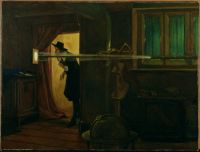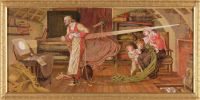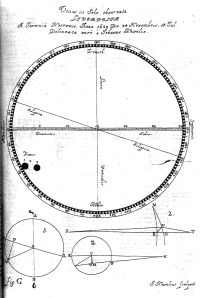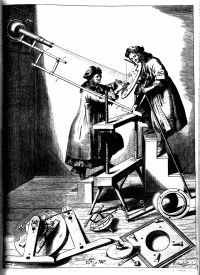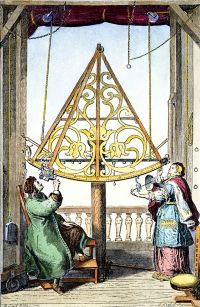|
Written on Venus's transit of 1639 Horrocks 1639, Schematic of the Sun [[ Whatton-Horrocks-image ]] The young English Jeremiah Horrocks (1619-1641) noted some mismatches between Kepler’s “Rodolphines Tables” and the Venus observations performed around 1590 by Tycho Brahé. He predicted a “probable” transit of Venus on Sunday November 24th (which corresponds to December 4th in the Gregorian calendar). He was lucky enough to observe it in Hoole (35 km north of Liverpool) half an hour before sunset. He made three measurements of the distance of Venus to the center of the sun’s disc (at 3 :15 pm, 3 :35 pm and 3 :45 pm, just before sunset at 3 :50 pm). He drew the Venus positions as observed on the sun’s disc in horizontal coordinates (with the zenith oriented to the top). The ecliptic is inclined of 21° with respect to the horizontal direction, and Venus moves from left to right. The position noted (1) indicates the internal contact at 3 :15 pm. Position (3), at 3 :45pm, is observed on the horizon. Horrocks estimated a value of Venus diameter of 1' 12" (which he later corrected to 1' 16"). His friend William Crabtree (1610-1644) observed this same transit in Manchester. Horrocks died prematurely two years later ; his manuscript Venus in Sole visa (Venus seen on the Sun) was published in 1662 by Johannes Hevelius (1611-1687) as a supplement series to Mercurius in Sole visus Gedani (Mercure seen on the Sun at Gdansk, in 1661). Horrocks, text [[Whatton-Horrocks]] This is the English translation of the Latin text of Horrocks (1639) done by Arundell B. Whatton (1859) ; just before this translation a summary of Horrocks life is presented. The schematic of the Sun and the Venus positions are presented page 122. Jeremiah Horrocks (1619-1641) observed the Venus transit on the horizon, just before sunset, by projecting the Sun’s image on a screen, through a lens telescope. Painting from Eyre Crowe (1824-1910). This painting from Ford Madox Brown (1821-1893) represents William Crabtree observing from Manchester. The Venus transit started when the Sun was 5° above horizon, about 50 minutes before sunset. This painting is sometimes called by mistake "Horrocks observing Venus transit in 1639" and attributed to the wrong author Eyre Crowe. Hevelius 1661, Mercurius in Sole visus Gedani [[ 13-03-(001 à 039) ]]
Ferguson 1760, A plain method [[ 1605-(045 à 049) ]] The English James Ferguson (1710 -1776) published in 1760, at the end of his book about the transit of 1761, a description of Horrocks observations.
This print represents a sextant, an instrument equipped with a mobile lens telescope hat can rotate on a fraction of 1/6 of a circle (this fraction is at the origin of the instrument’s name). Prolange, Journal des Sçavans (déc. 1761) p. 835-837 [[ JdS-1761 p.835-837 ]] Prolange (died around 1773), barrister at the Parliament, recomputed the observing circumstances of the Venus transit of 1639 (observed by Horrocks) by using new data on Venus, such as its diameter, as observed during the 1761 transit. The precision of the calculations is exceptional : 4" only on the longitude of the Venus’ orbit node. |
|||||
